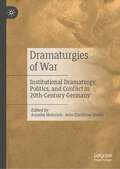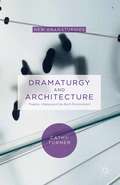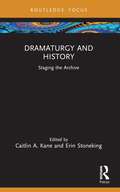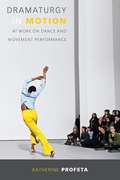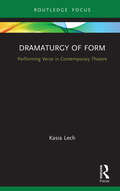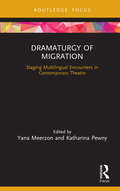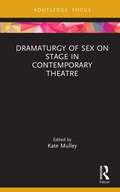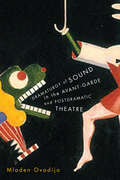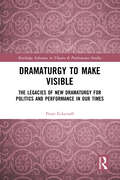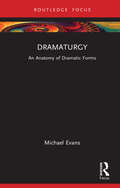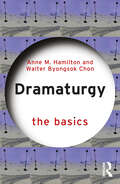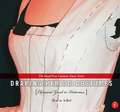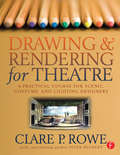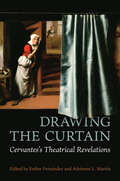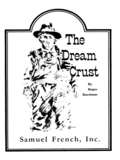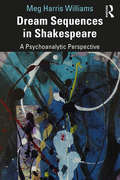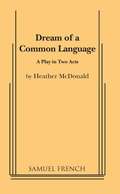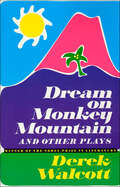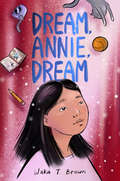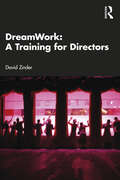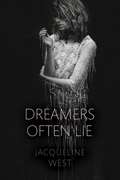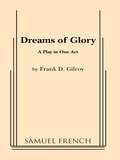- Table View
- List View
Dramaturgies of War: Institutional Dramaturgy, Politics, and Conflict in 20th-Century Germany
by Anselm Heinrich Ann-Christine SimkeThis book examines the institutional contexts of dramaturgical practices in the changing political landscape of 20th century Germany. Through wide-ranging case studies, it discusses the way in which operationalised modes of action, legal frameworks and an established profession have shaped dramaturgical practice and thus links to current debates around the “institutional turn” in theatre and performance studies. German theatre represents a rich and well-chosen field as it is here where the role of the dramaturg was first created and where dramaturgy played a significantly politicised role in the changing political systems of the 20th century. The volume represents an important addition to a growing field of work on dramaturgy by contributing to a historical contextualisation of current practice. In doing so, it understands dramaturgy not only as a process which occurs in rehearsal rooms and writers’ studies, but one that has far wider institutional and political implications.
Dramaturgy and Architecture: Theatre, Utopia and the Built Environment (New Dramaturgies)
by Cathy TurnerDramaturgy and Architecture approaches modern and postmodern theatre's contribution to the way we think about the buildings and spaces we inhabit. It discusses in detail ways in which theatre and performance have critiqued and intervened in everyday spaces, modelled our dreams or fears and made proposals for the future.
Dramaturgy and Dramatic Character
by William StormDramatic character is among the most long-standing and familiar of artistic phenomena. From the theatre of Dionysus in ancient Greece to the modern stage, William Storm's book delivers a wide-ranging view of how characters have been conceived at pivotal moments in history. Storm reaffirms dramatic character as not only ancestrally prominent but as a continuing focus of interest. He looks closely at how stage figures compare to fictional characters in books, dramatic media, and other visual arts. Emphasis is sustained throughout on fundamental questions of how theatrical characterization relates to dramatic structure, style, and genre. Extensive attention is given to how characters think and to aspects of agency, selfhood, and consciousness. As the only book to offer a long view of theatrical characterization across this historical span, Storm's dramaturgical and theoretical investigation examines topics that remain vital and pertinent for practitioners, scholars, students of theatre and literature, and general audiences.
Dramaturgy and History: Staging the Archive (ISSN)
by Caitlin A. Kane Erin StonekingDramaturgy and History provides a practical account of an aspect of dramaturgical practice that is often taken for granted: dramaturgs’ engagements with history and historiography.Dramaturgs play a vital role in amplifying and activating theatre’s unique potential to contribute to the pressing public discourse around the uses and legacies of history.This collection challenges the notion of history as an unassailable or settled set of facts, offering readers a glimpse into the processes and methods of eighteen dramaturgs working in a variety of settings, including professional theatres, universities, museums, and archives. The dramaturgs featured use history to a variety of ends: they reframe classical texts for contemporary audiences; advocate for the production of lesser-known writers and the expansion of the canon; create new works that bring women’s, LGBTQIA+, and Global Majority histories to life; and establish new and necessary archives by/of/for minoritarian artists. Collectively, they examine and animate some of the most urgent questions, concerns, and challenges that dramaturgs encounter in working with history.An essential resource for teachers and students of dramaturgy, the collection offers a concluding hands-on exercise for each chapter to facilitate the reader’s application of the methods discussed in their own practice.
Dramaturgy in Motion
by Katherine ProfetaDramaturgy in Motion innovatively examines the work of the dramaturg in contemporary dance and movement performance. Katherine Profeta, a working dramaturg for more than fifteen years, shifts the focus from asking "Who is the dramaturg?" to "What does the dramaturg think about?" Profeta explores five arenas for the dramaturg's attention--text and language, research, audience, movement, and interculturalism. Drawing on her extended collaboration with choreographer and visual artist Ralph Lemon, she grounds her thinking in actual rehearsal-room examples and situates practice within theoretical discourse about contemporary dramaturgy. Moving between theory and practice, word and movement, question and answer until these distinctions blur, she develops the foundational concept of dramaturgical labor as a quality of motion. Dramaturgy in Motion will be invaluable to practitioners and scholars interested in the processes of creating contemporary dance and movement performance--particularly artists wondering what it might be like to collaborate with a dramaturg and dramaturgs wondering what it might be like to collaborate on movement performance. The book will also appeal to those intrigued by the work of Lemon and his collaborators, to which Profeta turns repeatedly to unfold the thorny questions and rich benefits of dramaturgical labor.
Dramaturgy of Form: Performing Verse in Contemporary Theatre (Focus on Dramaturgy)
by Kasia LechDramaturgy of Form examines verse in twenty-first-century theatre practice across different languages, cultures, and media. Through interdisciplinary engagement, Kasia Lech offers a new method for verse analysis in the performance context. The book traces the dramaturgical operation of verse in new writings, musicals, devised performances, multilingual dramas, Hip Hop theatre, films, digital projects, and gig theatre, as well as translations and adaptations of classics and new theatre forms created by Irish, Spanish, Nigerian, Polish, American, Canadian, Australian, British, Russian, and multinational artists. Their verse dramaturgies explore timely issues such as global identities, agency and precarity, global and local politics, and generational and class stories. The development of dramaturgy is discussed with the focus turning to the new stylized approach to theatre, whose arrival Hans-Thies Lehmann foretold in his Postdramatic Theatre, documenting a turning point for contemporary Western theatre. Serving theatre-makers, scholars, and students working with classical and contemporary verse and poetry in performance contexts; practitioners and academics of aural and oral dramaturgies; voice and verse-speaking coaches; and actors seeking the creative opportunities that verse offers, Dramaturgy of Form reveals verse as a tool for innovation and transformation that is at the forefront of contemporary practices and experiences.
Dramaturgy of Migration: Staging Multilingual Encounters in Contemporary Theatre (Focus on Dramaturgy)
by Yana Meerzon Katharina PewnyDramaturgy of Migration: Staging Multilingual Encounters in Contemporary Theatre examines the function of dramaturgy and the role of the dramaturg in making a theatre performance situated at the crossroads of multiple theatre forms and performative devices. This book explores how these forms and devices are employed, challenged, experimented with, and reflected upon in the work of migrant theatre by performance and dance artists. Meerzon and Pewny ask: What impact do peoples’ movement between continents, countries, cultures, and languages have on the process of meaning production in plays about migration created by migrant artists? What dramaturgical devices do migrant artists employ when they work in the context of multilingual production, with the texts written in many languages, and when staging performances that target multicultural and multilingual theatregoers? And, finally, how do the new multilingual practices of theatre writing and performance meet and transform the existing practices of postdramatic dramaturgies? By considering these questions in a global context, the editors explore the overlapping complexities of migratory performances with both range and depth. Ideal for scholars, students, and practitioners of theatre, dramaturgy, and devising, Dramaturgy of Migration expresses not only the practicalities of migratory performances but also the emotional responses of the artists who stage them.
Dramaturgy of Sex on Stage in Contemporary Theatre (Focus on Dramaturgy)
by Kate MulleyDramaturgy of Sex on Stage in Contemporary Theatre explores the dramaturgy of sex in contemporary works for the stage in the social, cultural and historical context of the time and place during which they were written and performed. Comprising chapters by writers from across North America and Europe, the book covers an expansive range of plays, musicals and dance performances, from Broadway to the Fringe, from post-AIDS epidemic to post-COVID-19 pandemic. Analysing these intimate moments—both textually and as staged—through an intersectional and critical lens illuminates the way power structures are maintained and codified, and how they can be queered and dismantled onstage and off. This examination of depictions of sex on stage attempts to understand from a dramaturgical and sociological perspective how these depictions have developed over time, and how the rise of intimacy directors has responded to the changes within the contemporary theatrical landscape and in the world at large. This is an essential companion for any scholar or practitioner looking to stage, discuss or understand intimacy in performance.
Dramaturgy of Sound in the Avant-garde and Postdramatic Theatre
by Mladen OvadijaSound is born and dies with action. In this surprising, resourceful study, Mladen Ovadija makes a case for the centrality of sound as an integral element of contemporary theatre. He argues that sound in theatre inevitably "betrays" the dramatic text, and that sound is performance. Until recently, theatrical sound has largely been regarded as supplemental to the dramatic plot. Now, however, sound is the subject of renewed interest in theatrical discourse. Dramaturgy of sound, Ovadija argues, reads and writes a theatrical idiom based on two inseparable, intertwined strands - the gestural, corporeal power of the performer's voice and the structural value of stage sound. His extensive research in experimental performance and his examination of the pioneering work by Futurists, Dadaists, and Expressionists enable Ovadija to create a powerful study of autonomous sound as an essential element in the creation of synesthetic theatre. Dramaturgy of Sound in the Avant-garde and Postdramatic Theatre presents a cogent argument about a continuous tradition in experimental theatre running from early modernist to contemporary works.
Dramaturgy of Sound in the Avant-garde and Postdramatic Theatre
by Mladen OvadijaSound is born and dies with action. In this surprising, resourceful study, Mladen Ovadija makes a case for the centrality of sound as an integral element of contemporary theatre. He argues that sound in theatre inevitably "betrays" the dramatic text, and that sound is performance. Until recently, theatrical sound has largely been regarded as supplemental to the dramatic plot. Now, however, sound is the subject of renewed interest in theatrical discourse. Dramaturgy of sound, Ovadija argues, reads and writes a theatrical idiom based on two inseparable, intertwined strands - the gestural, corporeal power of the performer’s voice and the structural value of stage sound. His extensive research in experimental performance and his examination of the pioneering work by Futurists, Dadaists, and Expressionists enable Ovadija to create a powerful study of autonomous sound as an essential element in the creation of synesthetic theatre. Dramaturgy of Sound in the Avant-garde and Postdramatic Theatre presents a cogent argument about a continuous tradition in experimental theatre running from early modernist to contemporary works.
Dramaturgy to Make Visible: The Legacies of New Dramaturgy for Politics and Performance in Our Times (ISSN)
by Peter EckersallThis book argues that dramaturgy makes things visible and does so in two distinct and interrelating ways: creative processes and formal elements of performance are rendered visible and readable; and performance dramaturgy becomes an expanded practice in which performance is a locus for creating wide-ranging events and activities.This exploration defines dramaturgy as a perceptibly transforming agency in the construction, presentation and reception of contemporary performance; and it shows how contemporary performance has an intrinsic dramaturgical aspect whose proliferation of dramaturgical practices has led to a far-reaching reinvention of what contemporary theatre is. In doing so, this book deals with a careful selection of performance practices, including theatrical adaptations, new media dramaturgy, contemporary dance, installation-performance, postdramatic theatre, visionary works by auteurs, and revivals of well-known stage shows.This study will be of great interest to students and scholars in theater studies, performance studies, cultural studies, curating, and dance scholarship.
Dramaturgy: An Anatomy of Dramatic Forms (Focus on Dramaturgy)
by Michael EvansHow are plays constructed? Taking this essential question and looking at a broad range of Western plays, from Greek tragedies through Ibsen, we can discern a remarkably stable set of dramaturgical principles.Some dramatists adhere to traditional principles to create meaning, while others delight in bending or breaking these conventions, seeking new ways to express meaning. In this book, Michael Evans discusses what he calls “standard dramaturgy” – a set of seven principles upon which most plays, from ancient Greek dramas to modern works, are based. He teases out seven traits found in most plays written before 1900 – and many popular plays and films since then. The book then looks at these key traits and how the playwrights of the Modernist era deliberately subvert them to create new methods of meaning. Examining each of these traits with well-chosen examples from dramatic literature, the book highlights these traits and illustrates how dramaturgs can understand instances of meaning within plays.Part of the Routledge Focus on Dramaturgy series, this book will interest scholars and students of dramaturgy, directing, and theatre studies.
Dramaturgy: The Basics (The Basics)
by Anne M. Hamilton Walter Byongsok ChonDramaturgy: The Basics introduces the art of dramaturgy, explaining how dramaturgy works, what a dramaturg is, and how to appreciate their unique contribution to theatre-making. A wide-ranging account of the role of this vital element of theatre helps students and aspiring performance makers to apply dramaturgy to a full spectrum of theatrical disciplines. This guidebook teaches dramatic theories and script analysis as essential skills for aspiring dramaturgs and illustrates the various methods of reading for specific functions of dramaturgy. Dramaturgy: The Basics offers practical step-by-step instructions on how to practice production dramaturgy, dramaturgy of new work, translation, adaptation, devised theatre, site-specific theatre, literary management, criticism, editing, producing, and dramaturgical innovation, with detailed questions to consider at each stage of the process. This book aims to help students develop a dramaturgical mindset, enabling them to build a critical, inquisitive, and socially conscious perspective that is beneficial in all professions and relationships. Resource lists, further reading guides, and chapter summaries make this an outstanding guidebook. An essential read for anyone hoping to make, understand, or discuss theatre, Dramaturgy: The Basics provides a clear, accessible resource for approaching this integral but often misunderstood facet of theatre-making.
Draping Period Costumes: (The Focal Press Costume Topics Series) (The Focal Press Costume Topics Series)
by Sharon SobelOne way of creating a theatrical costume is called flat patterning. This is when a costume designer uses a pattern made to the wearer's measurements to cut out and sew together a costume. In many cases flat patterning is the more appropriate method for creating a period costume - skirts, pants, and sleeves, for example. However, working in two-dimensions often does not translate correctly onto a three-dimensional dress form or person. Often a designer will need to tweak style lines on a garment once they see it worn, or a costume will need a quick adjustment right before going on stage. In those cases, designers need to know how to correctly drape a costume. Draping is also the best way to construct a period costume right from the start. The construction of garments in earlier centuries often constricted movement, especially in the area of the armhole. The very different size and proportions of contemporary people compared to those in previous centuries makes the use of period patterns difficult. A well-draped garment can give the impression of period accuracy while permitting the wearer greater freedom of movement. Having a mock-up pinned to the form in its early stages is quicker and easier to adapt than drafting a flat pattern, cutting it out of muslin and sewing it. It also provides the opportunity for greater creativity and adaptation as well as a better understanding of what fabric will and won't do. In Draping Period Costumes, Sharon Sobel explains in step-by-step detail the basics of draping and demonstrates the use of those basic skills in the creation of a representative selection of period costumes from a variety of time periods. Chapters are broken into time periods and have two parts: an analysis of how clothing was made and worn during that specific time period, and detailed instruction on draping techniques to construct the costume. Copiously illustrated, images allow this visual audience to easily follow along with detailed instructions. A part of the Costume Topics series, this book will be 256 pages, a snazzy 8.25 x 7.5 trim size, and spiral bound-a format consistently requested by our audience so that they can lay the book flat while working from it.
Drawing and Rendering for Theatre: A Practical Course for Scenic, Costume, and Lighting Designers
by Clare P. RoweDrawing and Rendering for Theatre, A Practical Course for Scenic, Costume, and Lighting Designers is designed for those of you who are theatrical designers and want to improve your drawing and rendering skills.This gorgeous full-color book includes many examples of student drawings, analyzed and critiqued for areas that need improvement. It also includes numerous examples of design renderings by professional theatrical designers. In addition to the general sections on drawing and painting, it includes separate chapters on costume, scenic, and lighting rendering that include information specific to these design areas.
Drawing the Curtain: Cervantes's Theatrical Revelations (Toronto Iberic)
by Esther Fernández Adrienne L. MartínMiguel de Cervantes’s experimentation with theatricality is frequently tied to the notion of revelation and disclosure of hidden truths. Drawing the Curtain showcases the elements of theatricality that characterize Cervantes’s prose and analyses the ways in which he uses theatricality in his own literary production. Bringing together the works of well-known scholars, who draw from a variety of disciplines and theoretical approaches, this collection demonstrates how Cervantes exploits revelation and disclosure to create dynamic dramatic moments that surprise and engage observers and readers. Hewing closely to Peter Brook’s notion of the bare or empty stage, Esther Fernández and Adrienne L. Martín argue that Cervantes’s omnipresent concern with theatricality manifests not only in his drama but also in the myriad metatheatrical instances dispersed throughout his prose works. In doing so, Drawing the Curtain sheds light on the ways in which Cervantes forces his readers to engage with themes that are central to his life and works, including love, freedom, truth, confinement, and otherness.
Drawing the Line: Technical Hand Drafting for Film and Television
by David McHenryDrawing the Line: Technical Hand Drafting for Film and Television is the essential resource for students and aspiring professionals studying and working in film and television design. The book covers all aspects of scenic drafting by hand – a technique still used in film and television because of its unparalleled emotive and aesthetic qualities. Discover how to draw the iconic scroll of a classical column or learn the difference between Flemish bond and English bond brickwork – it is all here! Other key features include the following: Beautifully illustrated, approachable, step-by-step instructions for every aspect of scenic drafting – specific to film and television; Illustrated explanations of camera lenses, including calculating aspect ratios and projections; Coverage of the four types of drafting projection: isometric, oblique, orthographic and axonometric; A comprehensive glossary of terms, including an illustration of each entry. This beautiful book is clear, accessible, and a must-have for any student aspiring to work in film and television design.
Dream Crust
by Roger KarshnerFull Length, Drama \ 3 m, 3 f, 1 boy \ Int. \ Frank Haynes, an earth loving farmer, has given up his hound-dogging and high times under the pressure of the family's admonition that "A man has got to get ahead." Haynes would be happy to do nothing but tend his farm and reap whatever profit it might generate. But he realizes that there are five mouths depending on him and the lure of big money available to him in a nearby big city factory too great to ignore. Set against a backdrop of the land locked Midwest, the play dramatizes a man's persistent, agonizing search for personal freedom and the sense of loss between father and son. \ "The play's spirit, its underlying warmth, particularly in the unspoken father son relationship, creates a world that's identifiable and that breathes."-L.A. Herald Examiner
Dream Sequences in Shakespeare: A Psychoanalytic Perspective
by Meg Harris WilliamsThis book takes a new approach to Shakespeare’s plays, exploring them as dream-thought in the modern psychoanalytic sense of unconscious thinking. Through his commitment to poetic language, Shakespeare offers images and dramatic sequences that illustrate fundamental developmental conflicts, the solutions for which are not preconceived but evolve through the process of dramatisation. In this volume, Meg Harris Williams explores the fundamental distinction between the surface meanings of plot or argument and the deep grammar of dreamlife, applied not only to those plays known as ‘dream-plays’ but also to critical sequences throughout Shakespeare’s oeuvre. Through a post-Kleinian model based on the thinking of Bion, Meltzer, and Money-Kyrle, this book sheds new light on both Shakespeare’s own relation to the play and on the identificatory processes of the playwright, reader, or audience. Dream Sequences in Shakespeare is important reading for psychoanalysts, playwrights, and students.
Dream of a Common Language
by Heather McdonaldDrama / 2m, 3f, 1m child / This intriguing work produced at the Berkeley Repertory Theatre and in New York was inspired by an actual incident: women were banned from the artists' dinner to plan the first Impressionist painting exhibit in 1874, even though works by women were to be shown. In the play, the dinner is at the home of Victor, a successful artist, and Clovis, an artist who no longer paints. After helping with the preparations and being excluded from the dining room, Clovis devises a "women only" dinner to be held outdoors. Winner of three 1995 Helen Hayes Awards including Best New Play.
Dream on Monkey Mountain and Other Plays
by Derek WalcottOn a Caribbean island, the morning after a full moon, Felix Hobain tears through the market in a drunken rage. Taken away to sober up in jail, all that night he is gripped by hallucinations: the impoverished hermit believes he has become a healer, walking from village to village, tending to the sick, waiting for a sign from God. In this dream, his one companion, Moustique, wants to exploit his power. Moustique decides to impersonate a prophet himself, ignoring a coffin-maker who warns him he will die and enraging the people of the island. Hobain, half-awake in his desolate jail cell, terrorized by the specter of his friend's corruption, clings to his visionary quest. He will try to transform himself; to heal Moustique, his jailer, and his jail-mates; and to be a leader for his people. Dream on Monkey Mountain was awarded the 1971 Obie Award for a Distinguished Foreign Play when it was first presented in New York, and Edith Oliver, writing in The New Yorker, called it "a masterpiece."Three of Derek's Walcott's most popular short plays are also included in this volume: Ti-Jean and His Brothers; Malcochon, or The Six in the Rain; and The Sea at Dauphin. In an expansive introductory essay, "What the Twilight Says," the playwright explains his founding of the seminal dramatic company where these works were first performed, the Trinidad Theatre Workshop.First published in 1970, Dream on Monkey Mountain and Other Plays is an essential part of Walcott's vast and important body of work.
Dream, Annie, Dream
by Waka T. BrownIn this empowering deconstruction of the so-called American Dream, a twelve-year-old Japanese American girl grapples with, and ultimately rises above, the racism and trials of middle school she experiences while chasing her dreams. <p><p> As the daughter of immigrants who came to America for a better life, Annie Inoue was raised to dream big. And at the start of seventh grade, she’s channeling that irrepressible hope into becoming the lead in her school play. <p><p> So when Annie lands an impressive role in the production of The King and I, she’s thrilled . . . until she starts to hear grumbles from her mostly white classmates that she only got the part because it’s an Asian play with Asian characters. Is this all people see when they see her? Is this the only kind of success they’ll let her have—one that they can tear down or use race to belittle? <p><p> Disheartened but determined, Annie channels her hurt into a new dream: showing everyone what she’s made of. <p><p> Waka T. Brown, author of While I Was Away, delivers an uplifting coming-of-age story about a Japanese American girl’s fight to make space for herself in a world that claims to celebrate everyone’s differences but doesn’t always follow through.
DreamWork: A Training for Directors
by David ZinderDreamWork: A Training for Directors provides a theoretical basis and a highly detailed, practical, step-by-step blueprint for developing a directorial concept for a play.Directing is a complex, multi-staged artistic process which, for the most part, is a collaborative work of art. The director works with designers, composers, choreographers and actors to create the performance that is eventually shown to an audience. In this process, there is one stage of the director’s work which is uniquely personal and individual: the creation of a directorial concept. This book concentrates on this crucial stage of the director’s work, offering a template for the creation of a directorial concept prior to embarking on the collaborative stage of the director’s work. The book follows the process from the choice of the text, through a series of clearly documented and structured sets of strategies with attendant examples, up to the creation of the director’s version of the original play - the adaptation - that is the starting point for the director’s dialogue with designers, composers, choreographers and actors.DreamWork: A Training for Directors is intended for directing students at universities or theatre academies, both at undergraduate and graduate levels, as well as directors at the beginning of their careers.
Dreamers Often Lie
by Jacqueline WestLiar meets Romeo and Juliet in this Shakespeare-inspired young adult novel about whether to trust yourself when everyone is telling you your instincts are wrong--for fans of Holly Black, Laini Taylor, and Black Swan, by New York Times bestselling author Jacqueline West. Jaye wakes up in the hospital, disoriented, and beset by a slippery morphing of reality into something else. She repeatedly sees a boy who she feels like she knows--but that's impossible. Determined to get back to school and back to A Midsummer Night's Dream, in which she's starring, she lies to her sister, her mom, and her doctors--she's fine, she says. She's fine, she's fine, she's fine. But then on her first day back, she takes a seat in class . . . next to the mysterious boy. Queasy with anxiety ("I can't see you," she hisses at him, "because you're not really here"), Jaye realizes this boy is, in fact, real. And he has no idea what she's talking about. Caught between this fascinating, empathetic new kid and her childhood friend turned recent love interest, Jaye begins to notice unnerving similarities between her circumstances and those of some of Shakespeare's most famous plays. Tingling banter and clandestine meet-ups give way to darker, muddier incidents. As things escalate to a frightening pitch, how much of what's happening is real, how much is in Jaye's head, and how much does it matter as she's hurtling toward a fateful end over which she seems to have no control?
Dreams Of Glory
by Frank D. GilroyA bitter sweet comedy \ 2 m., 2 f. \ Ext. \ Two late forties couples are at the country club dance. George Brewster finally admits to his wife and the other couple that he has indeed gained the long sought after presidency of his company. And he also tells them of that time long ago at his school prom when he had briefly filled in as piano player in Tommy Dorsey's band. Dorsey had given George a card with what he said was his private number-- and indicating George had promise. George has dreamed all these years of how exciting and satisfying his life might have been. Now, his career at its peak, he had called-- and learned that "dreams of glory" are-- just dreams.
